DriveWorks 3D File
The DriveWorks 3D File document type references .drive3d files created using your 3D CAD application.
The document can be displayed in the 3D Preview control to allow a
configurable 3D representation, optimized for Internet browsers, on a user form.
A DriveWorks 3D Document can assemble models together to create Assemblies or layouts in 3D. Appearances,
Textures, Scale and Lights can all be dynamically driven.
This can all be done without the need for SOLIDWORKS.
DriveWorks 21 changes how the underlying data of a DriveWorks 3D document is stored.
This has resulted in a significant reduction in file size of .drive3d files.
Loading times for DriveWorks 3D Scenes on both desktop and web have been reduced.
DriveWorks 3D Scenes are less resource intensive and are more performant.
Existing DriveWorks 3D files, produced with earlier versions of DriveWorks, can benefit from this using the Upgrade utility in the free DriveWorks 3D Viewer.
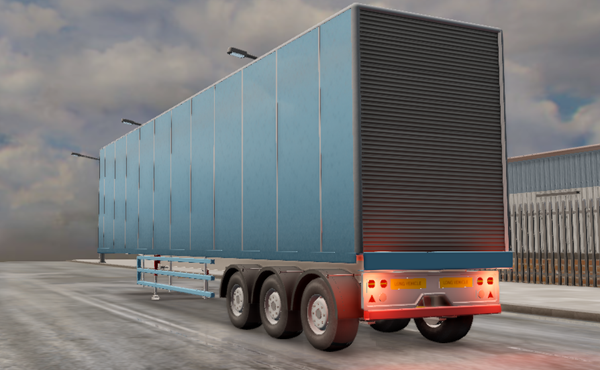
Render Batching
DriveWorks 3D technology utilizes two methods of render batching to deliver optimal performance when
loading 3D in a browser or client modules of DriveWorks.
- Static Baking
Automatically bakes all geometry that does not move, change appearance, or suppress states, into
one single combined geometry.
This allows the render of potentially huge static portions of scenes in one single draw call.
- Dynamic Instancing
This groups high-poly geometries and geometries using high resolution textures.
This allows the geometry to be sent to the GPU once, where all instances of that geometry are
rendered without re-uploading for each instance.
These two render batching methods combined allow the batching of almost all geometry in scenes, including
dynamic geometry.
This has resulted in major performance gains in the most intensive of scenes, and has significantly
improved VR scenes and FPS (frames per second).
Add a DriveWorks 3D File Document
In DriveWorks Administrator open the project and go to Stage4: Output Rules > Documents - 3D
- Click the Add button on the Command Bar to launch the 3D Document wizard.

- Enter a Name for the 3D Document in the Document Name field.
- If an Initial Drive3D file is required to be used (see How To: Create a Drive3D File for information on creating a .drive3d file to add to the Document.)
- Click the Browse button at the end of the Initial Drive3D File (Optional) field.
- Browse to the path of the required Drive3D file.
- Select any optional templates required for the scene. Choose from:
- Orbit Camera
Adds an orbit camera setup using rotators and a camera entity, giving better control over the camera than the default preview control camera.
- VR Rig
Adds a VR Camera rig set up with separate nodes for the head and hands.
- Three Point Lighting
Adds a three-point lighting rig to the scene comprising of 2 top-down, blue-tinted directional lights, 2 orange-tinted side lights, and 1 weaker up-light
- Soft Lighting
Adds a soft lighting rig to the scene comprising of 4 top-down directional lights and 1 weaker up-light.
- Hard Lighting
Adds a hard lighting rig to the scene comprising of 1 top-down directional light and 1 weaker up-light.
- Turntable Rotator
Adds a turntable node structure to the scene. Used to add additional models as children to give a continuous spinning effect.
- Ground Plane
Adds a basic plane model to the scene to act as the ground or base, to place models on and receive shadows.
- Click Finish.
Once the Document has been added the 3D Document editor will open.
To Edit a DriveWorks 3D File Document
Once the Document has been added, Edit mode is automatically activated.
To re-edit a DriveWorks 3D Document:
- Select the required DriveWorks 3D Document from the Document list.
- Select Edit from the Command Bar.
The DriveWorks 3D Document editor will open.
The DriveWorks 3D Document Editor is split into several sections:
- Command Bar
- Options Panel
- Feature Panel
- 3D View
- Parameter Panel
- Information Panel

Using configurations with Drive3D exports from SOLIDWORKS
When creating multiple Drive3D files from a single SOLIDWORKS part with more than one configuration, it is
important to ensure that the "Include configuration names in 3D exports" option is selected.
This can be found in the Settings menu, in the "SOLIDWORKS Settings" tab. Under Model Generation Options.
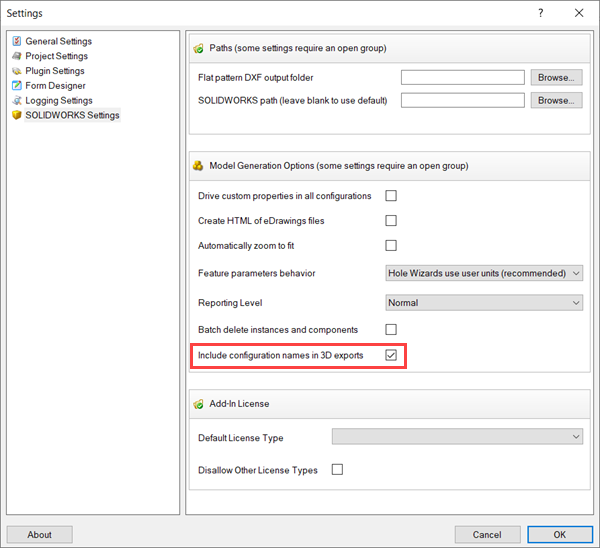
Command Bar
The Command Bar contains a number of features that are useful when using a DriveWorks 3D File Document.
- Cut (Ctrl + X)
- Copy (Ctrl + C)
- Paste (Ctrl + V)
- Undo (Ctrl + Z)
- Redo (Ctrl + Y)
- Search Rules (Ctrl + F)
- Apply Changes
This will apply any modifications made since opening a 3D Document in Preview Mode (does not save
changes). Closing and reopening the project will revert the 3D Document back to its last save point.
- Play Mode
Play Mode allows the 3D Document to be viewed and tested as it would appear in a Specification.
Animation entities (not assigned to a macro) will run as required.
The 3D View border is highlighted to indicate Play Mode is active.
Play Mode takes a snapshot of the current 3D Document.
The snapshot can be modified to allow experimentation of new features.
Any changes cannot be saved to the original Document.
Play Mode must be exited, by clicking the Play Mode button, to discard the snapshot and continue
modifying the original Document.
- Build
Build will become available when you have a rule selected with the Document. It opens the Rules
Builder to build a rule for that property.
- Refresh
Refresh will refresh the DriveWorks 3D File Document. It will obtain and update all of the data
required to build the 3D Document. This is useful when updating 3D Document Source Files.
- View As Combined
In a DriveWorks 3D Document it is possible to check multiple Nodes. The properties for each Node will
appear separately and rules can be built. View As Combined, combines properties from multiple Nodes
into one for each property name. This allows you to build one rule for multiple Nodes.
- Expand All
Expands the whole Feature Panel, including Assets folders.
- Collapse All
Collapses the whole Feature Panel, including Assets folders.
- Select All
Selects everything in the Feature Panel, including Assets folder features.
- Deselect All
Deselects everything in the Feature Panel, including Assets folder features.
- Import Drive3D File
Imports a DriveWorks 3D File into the 3D Document. If no Node is selected it will import the Model
onto the Root Node. Otherwise it will import the model onto the selected Node.
- Export Drive3D File
Takes the current DriveWorks 3D File Document and exports it as a standalone DriveWorks 3D File.
The following options are available before exporting the file:
- Zoom To Fit
Performs a Zoom To Fit on the Model shown in the 3D View. Allows the whole model to be seen in the 3D
View.
Selecting a Node from the Feature Panel, and clicking Zoom To Fit will display the whole of the
selected node.
- Show Camera Effects
Show Camera Effects allows the 3D View to appear as it would in a Specification. This shows the
default
camera, if hidden, and enables Camera Entities if added to the 3D Document.
- Hide Editor Icons
Click to hide sprites, used for entities in the editor view (cameras, lights, etc.).
- Display Performance Window
Click to display the Performance Window in the 3D View.
This gives key performance information about the 3D model being displayed.
See Display Performance Window for more information.
- Transform Tool Mode
Selecting a Node, or group of Nodes, from the Feature Panel or 3D View will display the Transform
Tool Mode to be selected.
This places a triad on the model which allows various transforms to be tested, in world space, by
clicking and dragging the required triad.
Holding control will enable snapping while dragging. This is in increments of 100mm, 15 degrees and
0.1 scale.
The transforms available are:
- None
This mode disables any other transform selected.
- Translate
The triad is displayed with arrows, which can be dragged to move nodes around.
- Rotate
This displays an interlocking circle triad, which can be dragged to rotate. All selected
items rotate around the averaged triad.
- Scale
Similar to translate triad but with squares on the end of the arrows.
Dragging will scale the selected nodes.
This only scales in XYZ, so rotated models will weight scaling based on rotation to get the
closest.
For example; a model rotated 45 degrees in Y and scaled in X will scale 50% in X and 50% in
Z.
Options Panel
This allows the following options, for the resulting DriveWorks 3D Document, to be controlled.
Document Name
This is the name of the new Document to be created.
To Build a File Name Rule
The rule for the File Name of the new Document is built by:
- Click the Build button at the end of the File Name Rule field

- Enter a name for the Document in the Rule Builder
Document Path
This is the location to store the new Document when it is created.
To Build a Path Rule
The rule for the path to store the new Document is built by:
- Click the Build button at the end of the Path Rule field

- Enter a qualified path in the Rule Builder that will be the location of the new Document.
Path Rule Examples
| Rule | Meaning |
|---|
| |
| "..\Documents" | Will go back a level (..\) from the project location and place the new Document in a folder
named Documents. If the Documents folder does not exist DriveWorks will create it when the
Document is created |
| "F:\DriveWorks\" & CustomerReturn & "\" & DWVariableOrderNumber & "\Documents"
| Will create the Document on the network drive F:\DriveWorks. From this point the folder
structure calculated by the input Customer, the variable OrderNumber and \Documents will be
created. |
| "\\FileServer\DriveWorks\" & CustomerReturn & "\" & DWVariableOrderNumber &
"\Documents" | Will create the Document on the UNC path \\FileServer\DriveWorks. From this point the folder
structure calculated by the input Customer, the variable OrderNumber and \Documents will be
created. |
Export File
When Drive3D Export Options is selected from the options panel a new menu will launch
displaying a list of General options:
- Create Drive3D - Creates a .drive3D file. Click Build to build a rule
for the file.
- Collapse Drive3D file - Collapses all Nodes in a document into a single Node and a
single Geometry. Click Build to build a rule for the file.
- Collapse and group by appearance - Group and merge geometries that share the same
Appearance. Click Build to build a rule for the file.
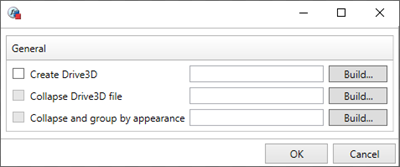
Create Drive3D
When checked DriveWorks will create a .drive3D file.
The Drive3D file will only be created when the Specification Transitions to a State where the Release Documents task is used.
Collapse Drive3D file
"Create Drive3D" must be checked to make this option available.
Collapse Drive3D file is an option that can be enabled when creating a Drive3D file from a DriveWorks 3D
Document.
This option will collapse all the Nodes in a 3D document down into a single Node. It will also collapse
all geometries to a single geometry that is used on that single Node. All Appearances will however be
maintained.
The result is a collapsed Node structure to a single Node and a single Geometry.
This collapse functionality can result in files that are larger than non collapsed files. This is because
all Geometry is being combined into one file. However, the reduced Node structure can result in smaller
scene files and better performance, it all depends on Geometry size.
Whilst all Geometries are collapsed into one file, they are stored and treated as separate geometries
inside the one Geometry. This can sometimes mean rendering performance doesn't improve. To improve
rendering performance look at using the setting Collapse and group geometries by
Appearance.
Please note that any Entities that are added to Nodes will not be exported.
However, temporary models that are replaced into the scene using the Replace Model Entity will be
exported as Geometry.
Collapse and group by appearance
"Create Drive3D" and "Collapse Drive3D file" must be checked to
make this option available..
Collapse and group geometries by appearance is an additional setting to Collapse Drive3D file . Rather
than keeping geometries separate in one file, this option will group and merge geometries that use the
same Appearance.
This means that if two or more geometries use the same Appearance they will be merged into a single
geometry. The benefit of doing this can be seen when the 3D file is rendering.
When a model is rendered by a graphics processor (GPU) it makes draw calls. A Draw Call is defined by a
model and an Appearance. If you have one model with one Appearance the GPU will make one Draw Call. If
you have a model that has four Appearances then four draw calls will be made on the GPU.
Collapse and group geometries by Appearance to improve rendering performance and keep the number of draw
calls to a minimum.
This is how you would render large scenes like factories or warehouses.
Like the previous setting, this can result in a Drive3D file being larger than the non-collapsed files.
Despite the file being potentially larger, it can still significantly improve performance and
implementations. All Appearances will be maintained as they are with the previous setting.
Also, if you have replacement models that are not being driven or changed, then we recommend collapsing
these as well to improve performance.
Please note that Entities that are added to Nodes will not be exported. However,
temporary models that are replaced into the scene using the Replace Model Entity will be exported as a
geometry.
Hide From Document List
When this setting is enabled (by checking the box) the document
will be hidden from the Documents list in the Specification
Explorer.
Feature Panel
The Feature Panel allows the selection of the following:
Features are modified or added by right clicking on any item and choosing the required menu item.
- Environment
Selecting this will display all parameters that can be applied in the Parameter Panel.
- Assets
This contains sub-folders for each asset that has been added to the 3D Document.
Selecting any asset will display all parameters that can be applied in the Parameter Panel.
- Root (Nodes)
This displays the Node structure of the 3D model.
Add or modify Nodes from the right click menu.
Add or modify entities to nodes from the right click menu.
Filter the Feature Panel
The Filter box at the top of the Feature Panel allows items to be filtered by name or type.
For example:
Type face in the Filter will display any feature that contains Face in the address.
Type entity:face in the Filter will display any entity feature that contains Face in the address.
3D View
When a Drive3D file has been added it will be displayed in the 3D View.
This is how the file will be viewed when applied to the 3D Preview Box
control.
The model view can be controlled with the mouse by:
- Rotate - left click and drag.
- Zoom - scroll the mouse wheel.
- Pan - right click and drag or mouse wheel click and drag.
Nodes can be selected from the 3D View.
Multi-select nodes from the 3D View by holding the CTRL key while selecting each node.
| Without a .drive3D model applied | With a .drive3D model applied |
|---|
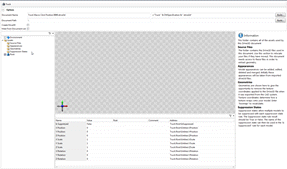 | 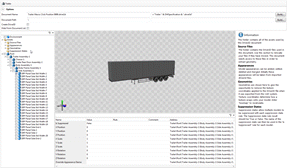 |
Parameter Panel
The Parameter Panel displays the parameters of any feature selected in the Feature Panel.

Parameters are displayed in a list with the following information:
- Name
The Parameter Name
- Value
The current value of the Parameter
- Rule
the Rule applied to the Parameter
- Comment
Any comment applied to the Rule
- Address
The full address of the parameter.
To build a rule for a selected parameter:
- Double click the required parameter from the list.
Or
Select the required parameter from the list and click the Build button from the command bar.
- Enter the rule in the Rule builder.
Additional Resources
MyDriveWorks - Tech Tips
3D Animate Views
Learn how to animate between views inside your 3D Previews using Camera and Animation Entities.
3D Camera
See how a custom Orbit Camera can be configured inside your 3D Previews.
3D Exploded View
This examples demonstrates how to setup an exploded view using the 3D Document's Animate Translate Entity.
3D Export Images
Find out how to export images of your 3D scenes for use inside your configurator's sales and manufacturing outputs.
MyDriveWorks - Tech Tips
3D Floor Plan
Upload a Floor Plan and configure the contents of each room in 3D.
3D Glow Entity
Find out how to highlight geometry in your 3D scene using the Glow Entity.
3D Layout
These Projects demonstrates how to setup an interactive 3D Layout using DriveWorks 3D Technology.
3D Path
Find out how to create a 3D path by interacting with a 3D scene.
MyDriveWorks - Tech Tips
3D Preview Modes
This demonstrates how each different DriveWorks 3D Mode works with a Project and comparison.
3D Rotator
Learn how to convert uploaded 3D files to Drive3D and display them on a rotator inside a 3D Preview.
3D Scale
Learn how to use a 3D Document node's scale properties to control the size of geometry in a 3D scene. Scaling geometry reduces 3D assets improving user experience.
3D Scene
Learn how a 3D Document's Environment Settings can be used to control your 3D Scene's appearence.
MyDriveWorks - Tech Tips
3D Selection
Learn how to make your 3D scenes interactive using Click Macro entities.
3D Using Decals
This example outlines ways you can use the DriveWorks 3D Decal Entity to enhance the user experience of your configurator.
3D Viewports
Find out how to create a Viewport inside your 3D Previews using the 3D Camera Entity.
3D Zoom To Fit
This example demonstrates how to perform a Zoom To Fit on your 3D Preview.
Tech Tips Index
View all available MyDriveWorks Tech Tips.
DriveWorks Tech Tips Index








